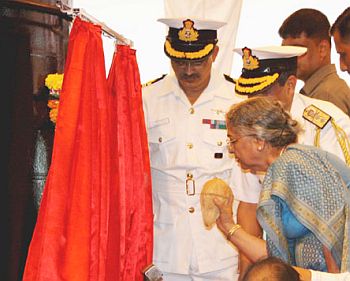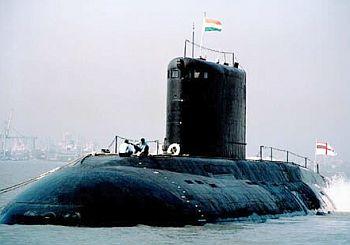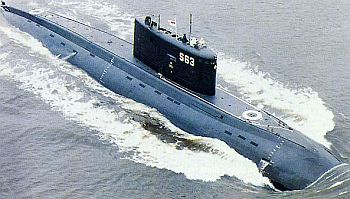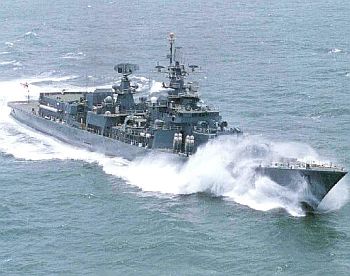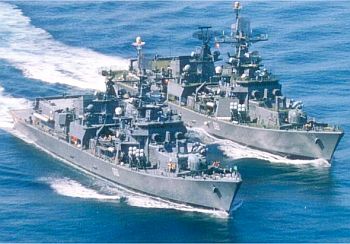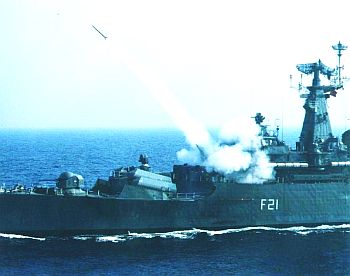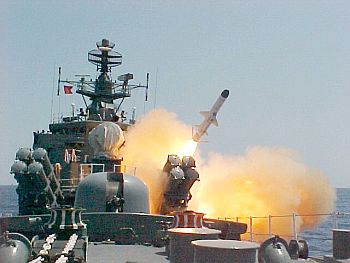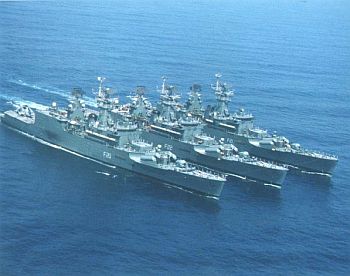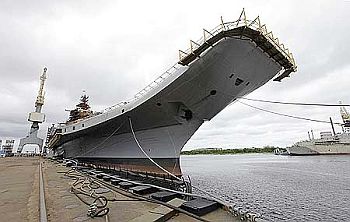 | « Back to article | Print this article |
How nuke sub Arihant will transform the navy
One hallmark of some of the world's path-breaking projects has been the choice of impressively lofty names. The first atomic bomb was built under Project Manhattan. Project Apollo put the first man on the moon. But for some reason, perhaps simply native modesty, one of India's most challenging technological developments -- its first nuclear-powered submarine -- has been cloaked in blandness.
When Prime Minister Manmohan Singh's wife, Gursharan Kaur, broke a coconut on the hull of what is referred to as the ATV or the Advanced Technology Vessel, to christen it INS Arihant, it launched a new era for the navy.
With the christening, water will be let into the Vishakhapatnam dock called The Shipbuilding Centre, from where INS Arihant will begin its underwater journey. Once submerged, it will undergo two years of extensive trials, first in harbour and then at sea, before formally joining the navy.
How nuke sub Arihant will transform the navy
Nuclear-powered submarines are of two types. Ballistic missile submarines, termed SSBNs in the US Navy (colloquial term: "boomers" or "bombers"), carry nuclear-tipped ballistic missiles.
These form the third leg of a country's nuclear triad: airborne, surface, and underwater-based launch platforms.
INS Arihant is a ballistic missile submarine armed with twelve K-15 missiles, each capable of carrying a 500-kg nuclear warhead to a target 750-km away.
It will be deployed almost continuously off the coast of any potential enemy, a virtually undetectable and indestructible missile launcher.
Two other boomers are under construction
The Arihant will not be alone. Two other boomers are under construction at L&T's Hazira plant. These will, probably, be followed by more -- equipped with longer-range nuclear-tipped missiles.
The second type of nuclear-powered submarine is the SSN, or attack submarine, armed with torpedoes and cruise missiles.
These operate as a part of the navy, performing the task of "sea denial", or preventing enemy ships -- both naval and commercial -- from using large expanses of the ocean.
An attack submarine's nuclear plant eliminates the need to surface, allowing it to remain underwater for months. India will shortly be leasing an advanced "Akula II class" attack submarine -- named INS Chakra -- from Russia, followed by a second after a year long interval.
Stable of surface warships is growing
In addition to a new fleet of nuclear submarines, a growing stable of major surface warships is catapulting the Indian navy into the league of serious maritime powers.
Cochin Shipyard is building a 40,000-ton indigenous aircraft carrier, which is likely to be commissioned into the Indian Navy in 2014, followed by a successor vessel in 2017. The controversial INS Vikramaditya, as the Gorshkov will be renamed, could also be commissioned by 2012.
Navy plans to boost warship numbers
The chief of naval staff, Admiral Sureesh Mehta, has publicly articulated the navy's plans to boost warship numbers to 165-170, up from 140 vessels today.
And because building ships in India costs less than half their cost abroad, India's three defence shipyards -- Mazagon Dock Limited, Mumbai; Garden Reach Shipbuilders and Engineers, Kolkata; and the smaller Goa Shipyard Limited -- have more warship orders than current capacities can handle.
The latest order placed on Mazagon and Garden Reach is for seven new-generation stealth frigates under Project 17A, 5600-ton warships, each capable of dominating vast stretches of ocean.
Logic behind India's rapid naval expansion
India's growing skill in integrating disparate sensors and weapons on indigenous warships gives them heavier punches than most other warships of the same weight class.
Senior naval planners explain the logic behind India's rapid naval expansion. Other than the great naval powers -- US, Russia and, now arguably, China -- most major navies operate in alliance with one of the big players.
Since the Cold War, for example, Britain's royal navy has functioned in alliance with the US navy, specialising in anti-submarine warfare, and relying on US cover for crucial aspects like anti-air defence.
'We need a balanced navy'
As a serving naval admiral elaborates, "India is different. We can operate for a short while as a partnership navy, but definitely not as part of a military alliance. We, therefore, need a balanced navy with all-round capability which can operate alone for as long as it takes."
But even while rejecting formal alliances, Indian navy admirals realise that to be taken seriously, a navy must be visible.That has spawned a series of annual exercises with foreign navies, including the Malabar series with the US Navy, the Varuna series with the French navy, the Konkan series with Britain's royal navy, and the Indra series with the Russian navy. Early this year, India sent three warships to China for the 60th anniversary celebrations of its navy.
'It's important to strut your stuff'
"It's important to strut your stuff," says a naval planner, "you visit a foreign port and invite your counterparts to a cocktail party on board. While sipping their drinks on the warship's deck, they are taking note of the weaponry you're carrying. You're sending a clear message."
The desire for a more powerful and visible navy is rooted in growing concern over India's 7,516 km of coastline, the vulnerability of which stood exposed during the 26/11 terrorist strikes.
Protection is also needed for an exclusive economic zone of 2 million sq km, which may go up to 2.5 million sq km once India's continental shelf is delineated and placed before the International Seabed Authority.
Naval officers point out that India's entire land mass is just 3.28 million sq km.
Navy is also expected to protect busy trade routes
A related argument marshalled by strong-navy enthusiasts is the protection of trade: 90 per cent of India's trade by volume and 77 per cent by value is transported by sea.
Especially vulnerable is the country's oil dependency; according to Hydrocarbon Vision 2025, India's current oil import level of 74 per cent of consumption will rise to 88 per cent of consumption by mid-century. Almost all of that comes by sea.
The navy is also expected to protect busy international trade routes that pass close by Indian shores (100,000 freight vessels annually; one billion tons of oil).
Naval planners point to the historic link between trade and military power. An officer explained, "In the colonial period, it was said that 'trade follows the flag'. Today, we see, as with China in Africa, the flag follows trade. But in no case can trade be divorced from the flag."
Infrastructure is the buzzword for the navy
An indicator of the navy's shift into the mainstream of Indian strategic planning -- more so than the growing number of capital warships -- is the growth in its command and administrative infrastructure.
The deep-water Karwar naval base, located 34 nautical miles (55 km) south of Goa, is already functioning. Aimed at decongesting Mumbai, Karwar will be base for more than 40 ships, including the aircraft carrier Vikramaditya when it is commissioned.
Also nearing completion is INS Kadamba, an administrative support base, commissioned in 2005. Another important addition is the new Naval Academy at Ezhimala, 280 km north of Kochi, inaugurated this January to train 750 cadets a year. You will need professionals to man the Indian Navy's growing fleet.
